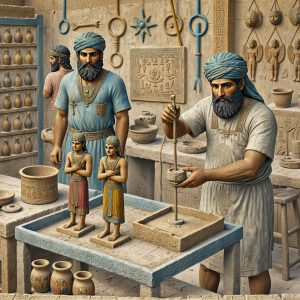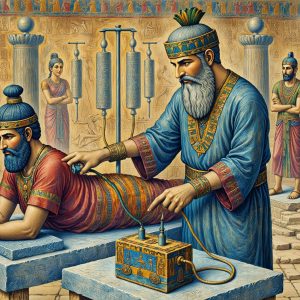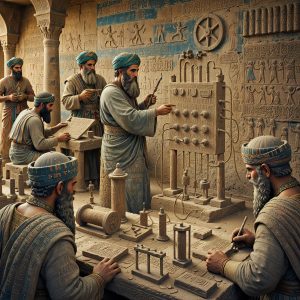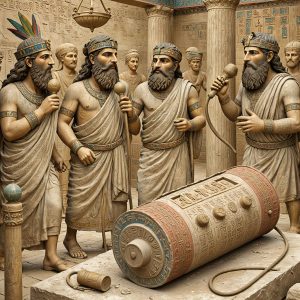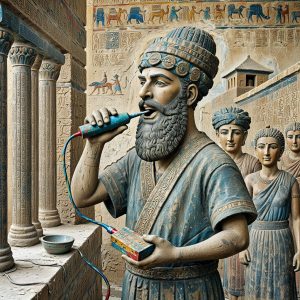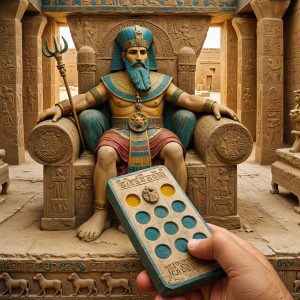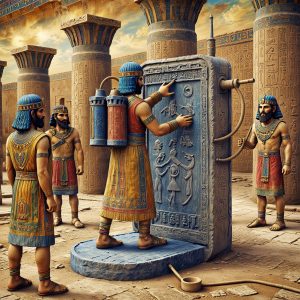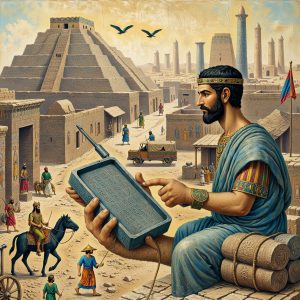In the annals of archaeological discoveries, few items spark as much curiosity and debate as the enigmatic “Babylonian Battery.” This ancient artifact, believed by some to be an early form of electrical battery, has puzzled scientists and enthusiasts alike. But what exactly is this object, and what role did it play in ancient Babylon? As we delve into the mystery, we’ll explore the serious hypotheses and some of the more humorous theories that have emerged over the years.
The Discovery
The so-called Babylonian Battery, officially known as the Baghdad Battery, was discovered in the 1930s near modern-day Baghdad, Iraq. This small, unassuming artifact consists of a clay jar, a copper cylinder, and an iron rod. When these components are assembled, they bear an uncanny resemblance to a galvanic cell—a basic type of battery. The discovery was made by German archaeologist Wilhelm König, who speculated that the device could have been used for electroplating or some form of primitive electrical experimentation.
Serious Theories
Electroplating
The most widely accepted theory among scholars is that the Babylonian Battery was used for electroplating—coating objects with a thin layer of metal using an electric current. This process would explain the presence of copper and iron, which are essential components in creating an electrochemical reaction. If true, this would suggest that the ancient Babylonians had a rudimentary understanding of electricity, predating modern batteries by over a millennium.
Religious or Medicinal Use
Another plausible explanation is that the device was used for religious or medicinal purposes. In ancient times, electricity was often associated with mystical or healing properties. The battery could have been used to produce small electric shocks, which might have been perceived as a form of divine intervention or therapeutic treatment.
Medical Therapy
The battery might have been used in early forms of electrotherapy. Small electric currents could have been applied for pain relief or other therapeutic benefits, demonstrating an ancient understanding of bioelectricity.
Electrostatic Experiments
It’s possible the Babylonians conducted experiments with static electricity. The battery could have been part of a primitive setup to study electrostatic phenomena, revealing early scientific curiosity and experimentation.
Chemical Storage
The battery might have been used to store or transport reactive chemicals safely. The jar’s design could have helped contain chemical reactions, making it a practical tool for early chemists.
Religious Symbolism
The battery might have held symbolic significance in religious rituals. Its ability to produce a mysterious force could have represented divine power, used in ceremonies to awe and inspire believers.
Not So Serious Theories
But let’s not get too bogged down in serious scholarly debate. The mystery of the Babylonian Battery has also inspired some delightfully outlandish theories that add a dash of humor to the story.
Ancient Aliens
No discussion of ancient mysteries would be complete without the obligatory nod to extraterrestrials. According to this theory, the Babylonian Battery was a gift from visiting aliens who shared their advanced technology with humanity. Perhaps these benevolent space beings wanted to jumpstart our technological development. Or maybe they just needed a way to charge their cosmic smartphones while on Earth.
The World’s Oldest Flashlight
Some have whimsically suggested that the Babylonian Battery was actually part of an ancient flashlight. Imagine Babylonian priests wandering the temple at night, using their primitive battery-powered torches to illuminate sacred texts. It’s a funny image, but it does beg the question: where were the light bulbs?
The Babylonian Electric Eel
One particularly amusing theory posits that the battery was part of an elaborate prank. Perhaps ancient Babylonians captured electric eels and needed a way to transport their shock-producing powers. By creating a battery-like device, they could harness the eel’s electricity for party tricks and practical jokes. After all, who wouldn’t want to surprise their friends with a jolt of eel-generated electricity?
Ancient Babylonian Karaoke Machine
Imagine the ancient Babylonians gathering around their battery-powered karaoke machine, belting out the latest hits in cuneiform. The battery might have powered a rudimentary microphone or speaker system, making sure everyone could hear the high priests’ rendition of “We Built This City.”
The First Electric Toothbrush
Hygiene is important, even in ancient times. Maybe the Babylonians were ahead of their time with a primitive electric toothbrush powered by the battery. Clean teeth and fresh breath were crucial for those royal court appearances.
Babylonian Bug Zapper
Perhaps the battery was used to keep pesky insects at bay. Imagine a Babylonian summer evening with a battery-powered bug zapper, ensuring that mosquitoes and other bugs didn’t spoil their feasts or ceremonies.
Babylonian Love Detector
What if the battery was used in a sort of ancient lie detector test, especially for matters of the heart? A young Babylonian might have hooked up their sweetheart to the device to see if their love was true, with a little jolt for every false answer.
Babylonian Remote Control
Picture this: the king lounging in his throne room, using a battery-powered remote control to operate various contraptions—opening doors, summoning servants, or even changing the channels on the palace’s entertainment system (whatever that might have been). A true testament to laziness and luxury!
Ancient Babylonian Time Machine
Maybe the battery powered a tiny time machine. Babylonians could take short trips to the future to peek at upcoming inventions. Imagine their surprise at discovering smartphones and electric cars.
Babylonian Brainstormer
Perhaps it was used in creative sessions where inventors received mild shocks to stimulate their brains, sparking brilliant ideas like the wheel or irrigation systems.
Babylonian Espresso Maker
The battery might have powered an early espresso machine, providing much-needed caffeine to keep scribes and scholars alert during late-night study sessions.
Babylonian Disco Light
Picture a disco light powered by the battery, with Babylonians dancing under flashing colored lights during festive celebrations. Ancient rave parties might have been all the rage.
Ancient GPS Device
The battery could have powered a rudimentary GPS device to help Babylonians navigate their sprawling city. “Turn left at the ziggurat” might have been the common phrase.
Wilhelm König: The Archaeologist Behind the Babylonian Battery
Biography: Wilhelm König was an Austrian archaeologist and painter, born in Vienna. In 1931, he became an assistant director at the Baghdad Antiquity Administration, where he made his most famous discovery—the so-called Baghdad Battery. This artifact, found at a Parthian site near Baghdad, consists of a clay jar with a copper cylinder and iron rod, speculated to be an early form of a galvanic cell.
Other Discoveries and Works: König’s work extended beyond this single artifact. He was involved in the creation of plaster castings of objects from the Iraq Museum, which were later exhibited in the Vorderasiatisches Museum in Berlin. He also published a book titled “Im verlorenen Paradies. Neun Jahre Irak,” which documents his nine years of archaeological work in Iraq. Another notable publication by König is “Ein galvanisches Element aus der Partherzeit?” which discusses his hypothesis about the battery.
Controversy: Despite König’s hypothesis, many archaeologists remain skeptical about the true purpose of the Baghdad Battery. Some experts, like Professor Elizabeth Stone, argue that the artifact is not a real battery and could have been used for ritualistic purposes instead.
For more detailed information about Wilhelm König and his work, you can refer to his Wikipedia page (Wikipedia).

